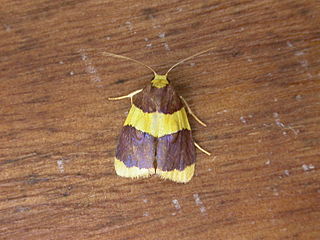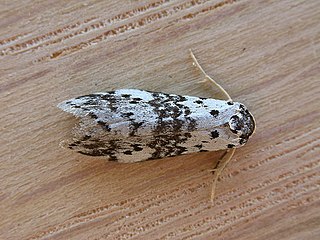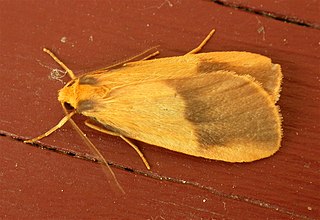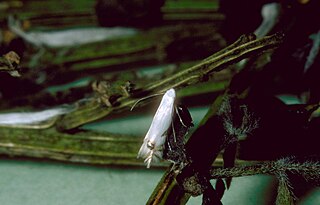Related Research Articles

The Lecithoceridae, or long-horned moths, are a family of small moths described by Simon Le Marchand in 1947. Although lecithocerids are found throughout the world, the great majority are found in the Indomalayan realm and the southern part of the Palaearctic realm.
Andesiana is a genus representing its own family Andesianidae and superfamily Andesianoidea, the "Andean endemic moths". It contains three species with a wingspan up to 5.4 cm. in female A. similis and 3.5 cm. in males. This far surpasses in size any previously known monotrysian moth. These large Microlepidoptera are restricted to Andean South America, from where they were described originally in 1989 in the family Cossidae by their discoverer Patricia Gentili.

Arrhythmica is a monotypic moth genus in the subfamily Arctiinae. Its single species, Arrhythmica semifusca, is found in Australia. Both the genus and species were first described by Turner in 1940.
Atelophleps is a monotypic moth genus in the subfamily Arctiinae. Its single species, Atelophleps tridesma, is found in Australia. Both the genus and the species were first described by Turner in 1940.

Halone is a genus of moths in the subfamily Arctiinae from southern Asia and Australia. The genus was erected by Francis Walker in 1854.

Heterallactis is a genus of moths in the family Erebidae erected by Edward Meyrick in 1886.
Heterotropa is a monotypic moth genus in the subfamily Arctiinae. Its single species, Heterotropa fastosa, is found in Australia's Northern Territory and Queensland. Both the genus and species were first described by Turner in 1940.
Oreopola is a monotypic moth genus in the subfamily Arctiinae. Its single species, Oreopola athola, is found in Australian island state ofTasmania. Both the genus and species were first described by Turner in 1940.
Phenacomorpha is a monotypic moth genus in the subfamily Arctiinae described by Turner in 1940. Its single species, Phenacomorpha bisecta, was first described by Thomas Pennington Lucas in 1891. It is found in Australia.

Philenora is a genus of moths in the subfamily Arctiinae. The genus was erected by Rudolph Rosenstock in 1885.
Pseudophanes is a genus of moths in the subfamily Arctiinae. Its single species, Pseudophanes melanoptera, is found in Australia. Both the genus and species were first described by Turner in 1940.

Scoliacma is a genus of tiger moths in the family Erebidae. The genus was erected by Edward Meyrick in 1886.

Thallarcha is a genus of moths in the subfamily Arctiinae.

Threnosia is a genus of moths in the subfamily Arctiinae.

Leucoptera is a genus of moths in the family Lyonetiidae. Its members are leaf borers many of which can cause severe damage to plant crops, such as coffee or apples.

Epicephala is a genus of moths in the family Gracillariidae.
Cuphodes is a genus of moths in the family Gracillariidae.

Xyloryctidae is a family of moths contained within the superfamily Gelechioidea described by Edward Meyrick in 1890. Most genera are found in the Indo-Australian region. While many of these moths are tiny, some members of the family grow to a wingspan of up to 66 mm, making them giants among the micromoths.
Ameleta is a monotypic moth genus in the subfamily Arctiinae. Its only species, Ameleta panochra, is found in Queensland, Australia. Both the genus and species were first described by Turner in 1940. The habitat consists of wet tropical areas.
References
- ↑ Savela, Markku (June 24, 2015). "Hesychopa Turner, 1940". Lepidoptera and Some Other Life Forms. Retrieved October 18, 2019.
| Wikimedia Commons has media related to Hesychopa . |
| Wikispecies has information related to Hesychopa |